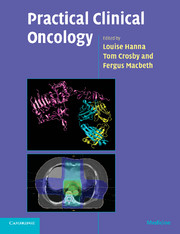Book contents
- Frontmatter
- Contents
- List of contributors
- Preface
- Acknowledgements
- Abbreviations
- 1 Practical issues in cytotoxic chemotherapy usage
- 2 Biological treatments in cancer
- 3 Hormones in cancer
- 4 Radiotherapy planning
- 5 Research in cancer
- 6 Oncological emergencies
- 7 Palliative care
- 8 Head and neck
- 9 Oesophagus
- 10 Stomach
- 11 Liver, gallbladder and biliary tract
- 12 Exocrine pancreas
- 13 Colon and rectum
- 14 Anus
- 15 Gastrointestinal stromal tumours
- 16 Breast
- 17 Kidney
- 18 Bladder
- 19 Prostate
- 20 Testis
- 21 Penis
- 22 Ovary
- 23 Body of the uterus
- 24 Cervix
- 25 Vagina
- 26 Vulva
- 27 Gestational trophoblast tumours
- 28 Lung
- 29 Mesothelioma
- 30 Soft tissue and bone tumours in adults
- 31 The lymphomas and myeloma
- 32 Central nervous system
- 33 Skin cancer other than melanoma
- 34 Melanoma
- 35 Thyroid
- 36 Neuroendocrine tumours
- 37 Cancer in children
- 38 Cancer of unknown primary
- 39 The use of radiotherapy in the treatment of benign conditions
- Multiple choice questions
- Multiple choice answers
- Index
- References
23 - Body of the uterus
Published online by Cambridge University Press: 23 December 2009
- Frontmatter
- Contents
- List of contributors
- Preface
- Acknowledgements
- Abbreviations
- 1 Practical issues in cytotoxic chemotherapy usage
- 2 Biological treatments in cancer
- 3 Hormones in cancer
- 4 Radiotherapy planning
- 5 Research in cancer
- 6 Oncological emergencies
- 7 Palliative care
- 8 Head and neck
- 9 Oesophagus
- 10 Stomach
- 11 Liver, gallbladder and biliary tract
- 12 Exocrine pancreas
- 13 Colon and rectum
- 14 Anus
- 15 Gastrointestinal stromal tumours
- 16 Breast
- 17 Kidney
- 18 Bladder
- 19 Prostate
- 20 Testis
- 21 Penis
- 22 Ovary
- 23 Body of the uterus
- 24 Cervix
- 25 Vagina
- 26 Vulva
- 27 Gestational trophoblast tumours
- 28 Lung
- 29 Mesothelioma
- 30 Soft tissue and bone tumours in adults
- 31 The lymphomas and myeloma
- 32 Central nervous system
- 33 Skin cancer other than melanoma
- 34 Melanoma
- 35 Thyroid
- 36 Neuroendocrine tumours
- 37 Cancer in children
- 38 Cancer of unknown primary
- 39 The use of radiotherapy in the treatment of benign conditions
- Multiple choice questions
- Multiple choice answers
- Index
- References
Summary
Introduction
The most common tumour affecting the body of the uterus is endometrial adenocarcinoma. The major risk factor for disease is unopposed oestrogen stimulation of the endometrium, which is associated with obesity; because of this, endometrial cancer is more common among women in developed countries. Most patients present with stage I disease and have a good prognosis when treated with a combination of surgery and selective postoperative radiotherapy. Other tumours affecting the body of the uterus include the uterine sarcomas, a group of tumours that may arise from the endometrium or the myometrium. These are aggressive tumours but treatment may be curative for early stage disease.
Gestational trophoblastic tumours are discussed in Chapter 27.
Types of tumour affecting the uterus
Approximately 90% of endometrial cancers are carcinomas, and approximately 90% of these are adenocarcinomas. Types of uterine tumour are shown in Table 23.1.
Incidence and epidemiology
The annual incidence of uterine cancer is 14.9 in 100,000 (CRUK National Statistics; see info.cancerresearchuk.org, accessed September, 2006). In 2002 there were 5600 new cases of uterine cancer diagnosed in the UK. Uterine cancer accounts for 4% of all female malignancies. The disease is more common in the Western world than in developing countries and more common in women with high socioeconomic status and nulliparity. The high incidence has been linked with increasing levels of obesity and physical inactivity (Schouten et al., 2004). Endometrial carcinoma occurs typically in the postmenopausal age group, and the median age is 60 years.
- Type
- Chapter
- Information
- Practical Clinical Oncology , pp. 267 - 277Publisher: Cambridge University PressPrint publication year: 2008

